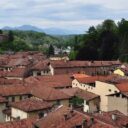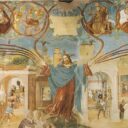Posted on Aug 19, 2014 in Villages |
Sette chilometri, una distanza piccola tutto sommato. Moltiplicatela per se stessa e otterrete la superficie di Castiglione Olona. Sette chilometri quadrati di tetti rossi e strade tortuose, acciottolati che s’insinuano tra le case e archi che introducono a cortili interni che ospitano ancora frammenti di Medioevo. La pianta del paese, più che a uno spunto topografico, deve la sua conformazione all’impronta di Branda Castiglioni, il cardinale che decise di farne una cittadella ideale del Rinascimento. Il suo intento di creare luoghi in cui appellarsi alle arti si tocca con mano, guardando alla costellazione di palazzi e chiese che costituisce la spina dorsale del borgo. Fu Branda a fondare la...
Posted on Sep 17, 2013 in Villages |
On the right bank of the Dora Baltea, in Val d’Aosta, is a residential fort that dates back to the 1400s. Issogne Castle takes its name from the nearby town. It was created in Renaissance style, sparingly adorned on the outside, almost austere, with towers that are only slightly higher than the fort itself. The surrounding defensive wall encloses a small courtyard, the center of which has a fountain in the form of a pomegranate tree made of wrought iron, with water flowing from its branches. The internal part of the defensive wall contain many frescoes depicting the coats of arms of the Challant family, who built the fort and owned it for many...
Posted on Sep 16, 2013 in Bergamo |
In the Odyssey, Homer describes the garden of Alcinous using the characteristics of a locus amoenus, an idealized place of comfort and pleasure, in the midst of the beauty of nature, in which part of the Odyssey takes place. Often this place is defined as a garden because part of its plants and flowers are cultivated, implying man’s intervention. The objective of the Arketipos Association is to promote, inform and enhance the culture of natural landscapes as well as those modified by human intervention. Together with the city of Bergamo, the Association is organizing I Maestri del Paesaggio – International Meeting of the Landscape and Garden. The event will...
Posted on Sep 13, 2013 in Eating |
“Ca se rispetta ‘a regola facenno ‘a vera pizza, chella ch’è nata a Napule quase cent’anne fa. Chesta ricetta antica se chiama Margarita, ca quanno è fatta a arte po ghì nant’ a nu re. Perciò, nun ‘e cercate sti pizze complicate ca fanno male ‘a sacca e ‘o stomaco patì” Set in a frame on the wall of the most famous and busiest pizzeria in Napoli, Antica Pizzeria da Michele or, as it is more commonly known, Da Michele, are the last few verses of this nursery rhyme entitled “‘A Margarita”, in the local Neapolitan dialect. It is an ode to margherita pizza done the old-fashioned way and reflects the pizzeria’s...
Posted on Sep 12, 2013 in Art Genres |
In this article we will explore how, from the 19th century onward, still life paintings have undergone unexpected yet dynamic changes. A piece of bread, a flower, a ripe fruit, a dusty bottle or a fork slightly off-center on a marble table: simple objects, items that make up everyday life. Things that seem to come to life, revealing the paradox behind the the term, “still life”. Man, his relationship with things, and the way in which art has changed his way of looking at things. In this article, we will try to understand how, from the 19th century onward, still life paintings have undergone unexpected yet dynamic changes. The question...
Posted on Sep 5, 2013 in Drinking |
The wine known as Nebbiolo reflects its history: the grapes used in its production are picked in late October, as the fog starts to roll in (“nebbia” in Italian). Thus, knowing the origin of the name, you can almost see the fog that rises up along the vines as you taste the wine, enveloping the grapes and rarefying the atmosphere. Even more evocative is the name Prima Nebbia (literally “first fog”), which is the name the Le Rocche dei Barbari wine cellar has given to its Nebbiolo, as its grapes are picked as the autumn weather turns foggy. The wine cellar is found in the heart of Barbaresco, a small town...
Posted on Aug 22, 2013 in Villages |
In the collective imagination, a castle is usually clinging to a rock cliff, hidden behind clouds and looking out majestically over a valley, protected by thick walls. From this image, we construct fantasies about courtly scenes, with dancing and music, sometimes from there moving on to conspiracies, bloody battles and lengthy sieges. In Otranto, a truly enchanting city in Puglia, the setting is a bit different, but no less interesting. There is an ancient castle in the city, but its walls seem to rise up from the limpid sea, forming, together with the water, a sort of defense for the town. This historical town and its cathedral represent one...
Posted on Aug 20, 2013 in Villages |
Even those who are not history scholars have heard of certain famous lineages, the Malatestas, the Sforzas, the Della Roveres, the Medicis, and the Borgias. These powerful families waged wars over centuries, passing their conflicts down from generation to generation, committing crimes and eliciting passions, mixing it all together with intrigues and subterfuge. But there is one element they have in common, Gradara Castle, one of the most beautiful in Italy, located on the border between the Marches and Romagna, atop a hill that looks out over the valley, with a view that stretches as far as the Adriatic Sea. Close your eyes and imagine a Medieval castle that...
Posted on Aug 1, 2013 in Photographers |
The best way to describe photographer Elliott Erwitt is “lightness”. Not “levity”, which would indicate a careless and superficial vision, but “lightness” refers to a delicate touch, not intrusive. His work is meticulous while at the same time reflecting a sort of weightlessness: gone are conceptual affectation and statements of meaning. Things are as they are, and it has never been so enticing to go back and look at them in this light. One of Erwitt’s favorite subjects is dogs. If you ask him why, he answers that he likes them, “and they don’t ask for reprints of the photos”. In addition to being the subjects in many of...
Posted on Jul 22, 2013 in Masterpieces |
February 1524. Throughout Italy, people were talking about something like the great flood that was believed to be coming. Astrologers had been foretelling such an event for some time, based on the alignment of the planets. Many people left their homes, seeking refuge in more secure places. Some even predicted the coming of the Anti Christ. Just a few years prior, the German theologian Martin Luther shook the foundations of the Catholic Church when he railed against the corruption that ran rampant in Rome. In response, in his Papal Bull in 1520, Leo X spoke of “barren vines that are not in Christ”. Martin Luther was excommunicated, but he...




 English
English Italian
Italian 











